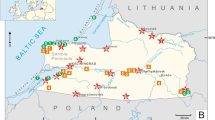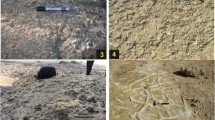Abstract
The Antarctic Treaty provides the general environmental policies for all areas south of parallel 60° S. In addition, some enclaves have a higher degree of environmental protection regulated by three categories: Antarctic Specially Protected Areas (ASPA), Antarctic Specially Managed Areas and Historic Sites or Monuments. Most of the protected areas in Antarctica have been designated based on the national geopolitical strategies, giving special attention to those areas where access and logistics are easier. This paper focuses on Elephant Point (Livingston, South Shetland Islands), an ice-free area of 1.16 km2 where activities are only regulated by the Antarctic Treaty System and no further environmental protection exists. By using a geoecological approach based on the geomorphology together with the distribution of the fauna and flora existing in the area, we have distinguished six geoecological environments in Elephant Point: Rotch glacier, proglacial environment, moraine system, bedrock plateaus, marine terraces and present-day beach. The distribution of fauna and flora is highly conditioned by the age of deglaciation as well as by the glacial, paraglacial and periglacial geomorphological landforms and processes. Besides this, five well preserved archaeological sites have been found in Elephant Point. These sites were used for sealers and whalers who sailed across the Maritime Antarctic during the eighteenth and nineteenth centuries. The rich biodiversity together with the high geomorphological and historical significance of this peninsula within the Maritime Antarctic constitutes the scientific basis to propose Elephant Point to be designated an ASPA in order to preserve the unique scientific heritage existing in this small peninsula.






Similar content being viewed by others
References
Anesio AM, Laybourn-Parry J (2012) Glaciers and ice sheets as a biome. Trends Ecol Evol 27:219–225
Anesio AM, Mindl B, Laybourn-Parry J, Hadson AJ, Sattler B (2007) Viral dynamics in cryoconite holes on a high Arctic glacier (Svalbard). Jof Geophys Res 112:G04S31. doi:10.1029/2006JG000350
Bañón M, Justel A, Velázquez D, Quesada A (2013) Regional weather survey on Byers Peninsula, Livingston Island, South Shetland Islands, Antarctica. Antarct Sci 25:146–156
Benayas J, Pertierra L, Tejedo P, Lara F, Bermúdez O, Hughes KA, Quesada A (2013) A review of scientific research trends within ASPA no. 126 Byers Peninsula, South Shetland Islands, Antarctica. Antarct Sci 25(2):128–145
Berguño J (1993a) Las Shetland del Sur: el ciclo lobero. Primera parte Bol Antarct Chileno:5–13
Berguño J (1993b) Las Shetland del Sur: el ciclo lobero. Segunda parte Bol Antarct Chileno:2–9
Bertrand K (1971) Americans in the Antarctica. 1775-1948, Am Geogr Soc. Special Publication, New York, p. 39
Casanova-Katny MA, Cavieres LA (2012) Antarctic moss carpets facilitate growth of Deschampsia Antarctica but not its survival. Polar Biol 35:1869–1878
Convey P, Hughes KA, Tina T (2012) Continental governance and environmental management mechanisms under the Antarctic Treaty System: sufficient for the biodiversity challenges of this century? Biodivers 13(3–4):234–248
Cook AJ, Vaughan DG (2010) Overview of areal changes of the ice shelves on the Antarctic Peninsula over the past 50 years. Cryosphere 4:77–98
del Valle RA, Montalti D, Inbar M (2002) Mid-Holocene macrofossil-bearing raised marine beaches at Potter Peninsula, King George Island, South Shetland Islands. Antarct Sci 14:263–269
Destéfani L (1988) La expedición española de 1819 y el Navío San Telmo. Investigaciones y Ensayos 38:77–107
Emslie SD (1995) Age and taphonomy of abandoned penguin rockeries in the Antarctic Peninsula Region. Polar Rec 3:409–418
Enzenbacher D (2007) Antarctic tourism policy-making. In: Triggs G, Riddell A (eds) Antarctica: legal and environmental challenges for the future. British Institute of International and Comparative Law, London, pp. 155–189
Fitte E (1982) Crónicas del Atlántico Sur: Patagonia, Malvinas y Antártida. EMECE, Buenos Aires
Fretwell PT, Hodgson DA, Watcham EP, Bentley MJ, Roberts SJ (2010) Holocene isostatic uplift of the South Shetland Islands, Antarctic Peninsula, modelled from raised beaches. Quat Sci Rev 29:1880–1893
Hodge J (1976) El Extremo Sur de América., Ed. América, Washington D.C.
Hughes KA, Convey P (2010) The protection of Antarctic terrestrial ecosystems from inter- and intra-continental transfer of non-indigenous species by human activities: a review of current systems and practices. Glob Environ Chang 20:96–112
Hughes KA, Pertierra LR, Walton DWH (2013) Area protection in Antarctica: how can conservation and scientific research goals be managed compatibly? Environ Sci Pol 31:120–132
IPCC (2014) Intergovernmental panel on climate change. World Meteorological Organization, Geneva
Ives JD, Barry RG (1974) Arctic and alpine environments. Methuen, London
King M, Padman L (2005) Accuracy assessment of ocean tide models around Antarctica. Geophys Res Lett 32:L23608. doi:10.1029/2005GL023901
Kuklinski P, Balazy P (2014) Scale of temperature variability in the maritime Antarctic intertidal zone. J Sea Res 85:542–546
Liggett DA, McIntosh A, Thompson A, Gilbert N, Storey B (2011) From frozen continent to tourism hotspot? Five decades of Antarctic tourism development and management, and a glimpse into the future. Tour Manag 32(2):357–366
López-Martínez J, Serrano E (2002) Geomorphology of Deception Island. In: López-Martínez J, Smellie JL, Thomson JW, Thomson MRA (eds) Geology and Geomorphology of Deception Island. British Antarctic Survey, Geomap Series, Cambridge, pp. 31–39
López-Martínez J, Serrano E, Schmid T, Mink S and Linés C (2012) Periglacial processes and landforms in the South Shetland Islands (northern Antarctic Peninsula region). Geomorphology 155:62–79
Macheret Y, Otero J, Navarro FJ, Vasilenko EV, Corcuera MI, Cuadrado ML, Glazovsky AF (2009) Ice thickness, internal structure and subglacial topography of Bowles Plateau ice cap and the main ice divides of Livingston Island, Antarctica, by ground-based radio-echo sounding. Ann Glaciol 50(51):49–56
Martin L (1940) Antarctica discovered by a Connecticut Yankeee, Captain Nathiel Brown Palmer. Geogr Rev 30(4):529–562
Michel RFM, Schaefer CEGR, López-Martínez J, Simas FNB, Haus NW, Serrano E, Bockheim J (2014) Soils and landforms from Fildes Peninsula and Ardley Island, Maritime Antarctica. Geomorphology 225:76–86
Michel RFM, Schaefer CEGR, Dias LE, Simas FNB, Melo-Benites V, Sá Mendonça E (2006) Ornithogenic Gelisols (Cryosols) from Maritime Antarctica. Soil Sci Soc Am J 70(4):1370–1376
Mieczan T, Górniak D, Świątecki A, Zdanowski M, Tarkowska-Kukuryk M (2013) The distribution of ciliates on ecology glacier (King George Island, Antarctica): relationships between species assemblages and environmental parameters. Polar Biol 36(2):249–258
Mora C, Vieira G, Pina P, Lousada M, Christiansen HH (2015) Land cover classification using high-resolution aerial photography in Adventdalen. Svalbard Geogr Ann A. doi:10.1111/geoa.12088
Oliva M, Ruiz-Fernández J (2015) Coupling patterns between paraglacial and permafrost degradation responses in Antarctica. Earth Surf Process Landf. doi:10.1002/esp.3716
Oliva M, Antoniades D, Giralt S, Granados I, Toro M, Pla-Rabes S, Vieira G (2014) La deglaciación holocena de la península Byers (isla Livingston, Antártida Marítima) a partir de la datación de sedimentos lacustres. Avances de la Geomorfología en España 2012-2014:523–526
Osmanoglu B, Navarro FJ, Hock R, Braun M, Corcuera MI (2014) Surface velocity and mass balance of Livingston Island ice cap, Antarctica. Cryosphere 8:1807–1823
Pertierra LR, Hughes KA (2013) Management of Antarctic Specially Protected Areas: permitting, visitation and information exchange practices. Antarct Sci 25(4):553–564
Pritchard HD, Vaughan DG (2007) Widespread acceleration of tidewater glaciers on the Antarctic Peninsula. J Geophys Res Earth Surf (2003–2012) 112(F3):F03S29. doi:10.1029/2006JF000597
Quesada A, Camacho A, Lyons WB (2013) Multidisciplinary research on Byers Peninsula, Livingston Island: a future benchmark for change in Maritime Antarctica. Antarct Sci 25(2):123–127
Remias D, Wastian H, Lütz C, Leya T (2013) Insights into the biology and phylogeny of Chloromonas polyptera (Chlorophyta), an alga causing orange snow in Maritime Antarctica. Antarct Sci 25(5):648–656
Rignot E, Mouginot J, Morlighem M, Seroussi H, Scheuchl B (2014) Widespread, rapid grounding line retreat of Pine Island, Thwaites, Smith and Kohler glaciers, West Antarctica from 1992 to 2011. Geophys Res Lett 41(10):3502–3509
Serrano E (2002) Hielo, montañas, mar y fauna: el turismo en las islas Shetland del Sur (Antártida marítima). Revue de Géographie Alpine 1(90):9–24
Serrano E, López-Martínez J, Cuchí JA, Durán JJ, Mink S, Navas A (2008) Permafrost in the South Shetland Islands (Maritime Antarctica): spatial distribution pattern. In: Kane DL, Hinkel KM (eds) Proceedings of 9th International Conference on Permafrost, vol 2. University of Alaska Fairbanks, Fairbanks, pp. 1621–1625
Slaney H (1921) Notice of the voyage of Edward Barnsfield, Master of his Majesty’s Ship Andromache, to New South Shetland. Edinburgh philosophical Journal 4:345–348
Stackpole E (1955) The Voyages of the Hurton and the Huntress: the American sealers and the discovery of the continent of Antarctica. Nabu Press, Connecticut
Steig EJ, Schneider DP, Rutherford SD, Mann ME, Comiso JC, Shindell DT (2009) Warming of the Antarctic ice-sheet surface since the 1957 IGY. Nature 457:459–462
Terauds A, Chown SL, Morgan F, Peat HJ, Watts DJ, Keys H, Convey P, Bergstrom DM (2012) Conservation biogeography of the Antarctic. Divers Distrib 18:726–741
Toro M, Camacho A, Rochera C, Rico E, Banon M, Fernández-Valiente E, Marco E, Justel A, Avendano MC, Ariosa Y, Vincent WF, Quesada A (2007) Limnological characteristics of freshwater ecosystems of Byers. Polar Biol 30(5):635–649
Torres-Mellado JA, Jaña R, Casanova-Katny MA (2011) Antarctic hairgrass expansion in the South Shetland archipelago and Antarctic Peninsula revisited. Polar Biol 34(11):1679–1688
Troll C (1968) Geoecology of the Mountainous regions of the Tropical Americas. Ferd. Dümmers Verlag, Bonn
Troll C (1972) Geoecology of the High-Mountain regions of Eurasia. Erdwissenschaftsliche Forschung der Akademie der Wissenschaften und der Literatur. Franz Steiner Verlag GMBH, Mainz
Troll C (1973) The upper timberlines in different climatic zones. Arct Alp Res 5(3):3–18
Turner J, Colwell SR, Marshall GJ, Lachlan-Cope TA, Carleton AM, Jones PD, Lagun V, Reid PA, Iagovkina S (2005) Antarctic climate change during last 50 years. Int J Climatol 25:279–294
Vera ML (2011) Colonization and demographic structure of Deschampsia Antarctica and Colobanthus quitensis along an altitudinal gradient on Livingston Island, South Shetland Islands, Antarctica. Polar Res 30:7146
Verbitsky J (2013) Antarctic tourism management and regulation: the need for change. Polar Rec 49(250):278–285
Vieira G, Bockheim J, Guglielmin M, Balks M, Abramov AA, Boelhouwers J, Cannone N, Ganzert L, Gilichinsky D, Goryachkin S, López-Martínez J, Raffi R, Ramos M, Schaefer C, Serrano E, Simas F, Sletten R, Wagner D (2010) Thermal state of permafrost and active-layer monitoring in the Antarctic: advances during the international polar year 2007-2008. Permafrost Periglac 21:182–197
Vieira G, Mora C, Pina P, Schaefer CE (2014) A proxy for snow cover and winter ground surface cooling: mapping Usnea sp. communities using high resolution remote sensing imagery (maritime Antarctica). Geomorphology 225:69–75
Watcham EP, Bentley MJ, Hodgson DA, Roberts SJ, Fretwell PT, Lloyd JM, Larter RD, Whitehouse PL, Leng MJ, Monien P, Moreton SG (2011) A new relative sea level curve for the South Shetland Islands, Antarctica. Quat Sci Rev 30:3152–3170
Zarankin A, Senatore MX (2005) Archaeology in Antarctica, 19th century capitalism expansion strategies. Int J Hist Archaeol 9(1):43–56
Zarankin A, Senatore MX (2007) Historias de un pasado en blanco; Arqueología Histórica Antártica. Argumentum, Belo Horizonte
Acknowledgments
M. Oliva thanks the AXA Research Fund for sponsoring his research, and A. Casanova-Katny acknowledges the support of the General Directorate of Research and Postgraduate Studies of the Catholic University of Temuco, DGIPUCT N° CD2010-01. This study was financially supported by the Portuguese Polar Program (PROPOLAR) and the research project HOLOANTAR (Holocene environmental change in the Maritime Antarctic. Interactions Between permafrost and the lacustrine environment), both funded by the Portuguese Science Foundation. Funding was also provided by the project 1120895 of the FONDECYT (Fondo Nacional de Desarrollo Científico y Tecnológico, Chile). The archaeological research has been funded by the PROANTAR/CNPq (Brazil). We acknowledge the Brazilian and Chilean Antarctic programmes for their logistic support in the field.
Author information
Authors and Affiliations
Corresponding author
Rights and permissions
About this article
Cite this article
Oliva, M., Ruiz-Fernández, J., Zarankin, A. et al. Geoecology and Historical Heritage in the Ice-Free Area of Elephant Point (Antarctica). Proposal for Future Environmental Protection. Geoheritage 9, 97–109 (2017). https://doi.org/10.1007/s12371-016-0184-1
Received:
Accepted:
Published:
Issue Date:
DOI: https://doi.org/10.1007/s12371-016-0184-1




